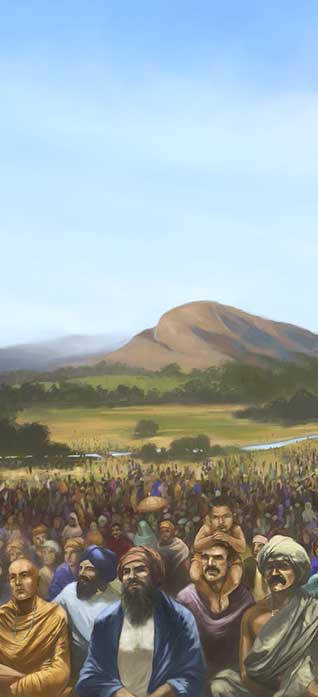Books
Raja Rattan Rai:
Part III
Bhai VIR SINGH. Translated from Punjabi by BIMAL KAUR
Extracts from ‘Sri Guru Kalgidhar Chamatkar’ (1925), by Bhai Vir Singh
Continued from yesterday …
Chapter 6
The Raja was in an elevated mood. Yet, he said not a word. He was savouring the feeling of fulfilment of a long-awaited wish. His face shone, serenity filled him from head to toe. He had never felt more alive and looked at his surroundings with fresh awareness.
His Mother could sense what was going through her son’s mind. She knew that Guru Sahib’s darshan had made a deep impact on him, bringing his inner self alive with His touch. She did not want anything or anyone to disturb his new-found peace and joy. She wanted that he should eat and go to bed as he had to be ready early for the morning darbar.
So she did not engage him in any talk and when he slept, she sat near him and recited Kirtan Sohela, followed by the six stanzas of Guru Ramdas’ Swayyey and finally, the complete Anand Sahib.
Then she too, went to sleep.
Very early in the morning, she awoke, had her bath and after completing the recitation of nitnem, she sat down near her son and recited Sukhmani Sahib in a slow, sweet voice, creating an ethereal atmosphere. When the paatth came to an end, the Raja opened his eyes. The first word that passed his lips was, ‘Waheguru’!
The sweetness with which the word was uttered pierced the Mother’s heart. Tears of gratitude formed in her eyes as she thought, “My son has felt the spiritual love I was praying for. The seed has taken root. He will no longer be tempted by the false attractions of this world. He has found a focus, a spiritual home where he will be nurtured to a higher state of living.”
With these thoughts running in her mind, her gratitude to Waheguru poured out in the words, “shukar, shukar, shukar” as she woke up her son.
The Raja quickly bathed and dressed in his royal robes, donning the weapons he generally carried on his person. Accompanied by his ministers, the Raja reached the diwan which was already filled with people. Guru Sahib sat on His seat with His eyes closed. The kirtanee jatha was busy playing softly on their instruments. No other sound could be heard. The Raja and his companions bowed deeply and quietly sat down to one side.
As the first rays of the sun pierced the tent, Satgur ji opened His eyes. The raagis began to sing ‘Aasa di Vaar’, creating a magnetic atmosphere which held everyone in its thrall. No one moved till the bhog, when aardas was recited and parshad distributed to all the saadh sangat.
After a while, the Raja’s gifts for Guru Sahib were brought and opened. Guru Sahib was charmed by the five-in-one weapon and the stool with the chauparr game. Some rare weapons were then unpacked and their use demonstrated.
Outside, the horses and the black elephant waited in all their finery. The horses were first put through their paces. Then, it was the turn of the black elephant to show his tricks. Arrows were shot all over the ground and he collected all of them and brought them back. Lifting the lantern, he waved it as if showing the way in the dark. Then he picked up the chaur and waved it over the heads of Guru Sahib and the sangat. Finally, he picked up Guru Sahib’s shoes with his trunk and placed them at His feet.
Guru Sahib was very pleased and named him Parsadi. He then gave the order to take the elephant to the special stall and arranged for a mahawat who was to be trained by the one who had accompanied him all the way from Assam.
Soon the gifts were taken away. Everyone sat in silence as Guru Sahib had closed His eyes. In a while He looked up and spoke, “Rattan Rai, you arrived in this world as a blessing. You came from the darbar of Guru Nanak and were already a Sikh. Now, you are making a re-entry into the Sikh way of life.”
Guru Sahib looked lovingly at Rattan Rai and uttered “Waheguru!”
The Raja felt as if a current had vibrated through his whole body. His heart resonated with the word ‘Waheguru!’ and he felt the joy of it pierce his very core. He had received the divine gift directly from Guru Sahib. To his wonder, not only his tongue but every pore seemed to recite the naam. When he looked up at the sky and the trees around him, he had the wondrous experience of seeing waves of ‘Waheguru, Waheguru!’ emanating from them.
Guru Sahib had granted him the priceless boon by His grace:
“gura ik deh bujhayee / sabhna jeeya ka ik daata so mai vissar n jayee ..."
The Guru has revealed the Eternal secret that there is only one Lord God of all creatures and I must never forget Him [GGS:2].
The Raja would never forget Him for He had granted him that divine support which is required to achieve stability in one’s faith. For him, the search was over and the cup of his soul was filled to the brim with the love for Waheguru and gratitude for Guru Sahib who had brought him to this blissful state. He had not only received the gift of Anand (pure joy) but also of chardi kalaa which brought an energizing force to his body and mind.
The Raja stayed on in Anandpur for five months. In the early morning, he would accompany his mother to the darbar and listen to Aasa di Vaar. Towards evening, they would often go to Guru Sahib’s residence for darshan and listen to the wise words of His revered mother, Mata Gujari ji as she spoke of her experiences.
Whenever Guru Sahib went hunting, he would invite the Raja to join him. Often Parsadi, the elephant, was taken along and his antics enjoyed by all. Then they would go for a ride on him. In the cool waters of the Sutlej, they swam and sported with a touch of competitiveness.
All in all, it was a time of light-hearted activity and exuberance. Guru Sahib and the Raja were close to each other in age with similar interests in physical activity and adventure. What was remarkable was that even though Guru Sahib treated the Raja as an equal, a long-time friend, and not just His Sikh, the Raja responded with ever-increasing love and reverence towards Him.
It is a human weakness that when someone receives a great deal of love and recognition from a superior person, he begins to feel that he is the equal of the other and can demand any favour as his right. He becomes arrogant and his expectations increase. Rarely do we see a personality like the Raja’s who felt deeply grateful for the warmth and affection he received from Guru Sahib.
His humility made him question this gift because he felt that he did not deserve it. Thus, his feelings of gratitude and reverence increased and he could absorb Guru Sahib’s love and affection as a boon granted to him.
His mother looked on and sent up silent prayers of gratitude, while pleading with Waheguru to guide her son so that he understood the value of the gifts being granted to him and would continue to cherish the reverence and awe, which had brought him to the darbar.
Plans were made for the return journey and cancelled, at first by the Raja as he could not bear the thought of being parted from Guru Sahib, and then later when Guru Sahib Himself sweetly said: “Stay another ten days. What’s the hurry to go back?”
Time passed swiftly and finally the day was fixed for the return journey. The people of his kingdom needed the Raja to return and take care of their needs. This was the teaching of Guru Sahib and this was the Sikh path:
“vichay grih sadaa rahaiy udasi jiu kamal rahaiy vich pani hai ..."
Remain detached while leading a worldly life, the way the lotus flower does. It lives in the waters of the pond, yet does not let the water and slush affect its equanimity [GGS:1070].
From Guru Sahib the Raja had learnt the core lesson for the Sikh way of life: Man has to maintain only three relationships. The first is with the Almighty and for that he has to recite the Waheguru naam and remain in a state of ‘sadaa raho har naalay’. Guru Sahib had already established this link with Waheguru for the Raja.
The second follows from the first. This is the state of chardi kalaa which is always working at self-improvement.
The third is with the outer, physical world. This makes him aware of ‘sarbat da bhalaa’ or working for the welfare of humanity. It must, however, be done with the understanding that we are following Guru’s will and that this is His expectation from us.
Finally, the day of departure arrived. In the morning, the Raja and his mother first went to Guru Sahib’s residence. They met Mata Gujari ji, touched her feet and received loving blessings from her. Then they went to Guru Sahib and prostrated themselves at His feet, their tears not stopping as they offered their very souls in His safe-keeping.
Later, everyone gathered in the darbar. The atmosphere was filled with love and the sorrow of parting and it affected one and all. Guru Sahib took the Raja in a warm embrace. His Mama, Kirpal ji, brought some beautiful shawls, brocade pieces and weapons, which Guru Sahib presented to the Raja as ‘parsad’.
Lastly, He gave him a Nitnem Gutka (a small, portable volume of daily gurbani recitations).
Unlike His usual practice, Guru Sahib began to accompany the Raja and his companions to where their horses awaited, but the Raja bowed and touched His feet and pleaded:
“sabh bidh tey mujh kiyo nihaal ..."
You have blessed my present life with your whole-hearted generosity. Keep me safe in the next life, that is my fervent prayer [Suraj Parkash].
With eyes full of tears and his voice choked, the Raja received a final embrace from Guru Sahib and taking his mother’s hand, he escorted her where the rest of the party waited. He helped her into the palanquin and the cavalcade moved off. The Raja walked beside his mother’s palanquin, listening to her quietly reciting:
“maerae munn pardesi vey pyarae aao gharaey ..."
O my dear wandering mind, come to your real home. Bring about a union with Guru and Waheguru, my beloved, so that He may live in the heart forever [GGS:452].
* * * * *
Concluded.
[Sardarni Bimal Kaur, the translator, has embarked on a project to make available more of Bhai Vir Singh ji's works in English.]
March 2, 2017
Conversation about this article
1: Sangat Singh (Kuala Lumpur, Malaysia), March 06, 2017, 10:21 PM.
Bimal ji, so very nice to have you at long last in the sikhchic family and enriching it with your contribution with such an opus of poetic resonance. As a granddaughter of Bhai Sahib Vir Singh ji you have had the honour of having his hand on your head more than once. His touch alone can make a poet. Even an unlettered person would glow in his company. Bhai Sahib’s writings are spirituals and touch the soul. All in his company returned fulfilled. Please do translate 'Baba Naudh Singh' – a practical handbook of Sikhi. Also 'Gurmukh Sikhya'. I know you have been working on these for a long time and are sharing our religion of love.




